The Tsleil-Waututh Nation and Early Explorers
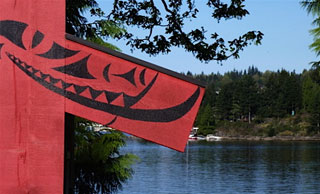 Belcarra Peninsula, the picnic area and Belcarra South is part of the traditional land of the Tsleil-Waututh Nation ("People of the Inlet"). According to the Tsleil-Waututh, it has been their traditional land and winter residence since time immemorial. They called their village Tum-tumay-whueton, "Big Place For All The People." Archaeologists working from artifacts estimate earliest settlement began about two millennia ago. A significant midden extends along the waterfront.
Belcarra Peninsula, the picnic area and Belcarra South is part of the traditional land of the Tsleil-Waututh Nation ("People of the Inlet"). According to the Tsleil-Waututh, it has been their traditional land and winter residence since time immemorial. They called their village Tum-tumay-whueton, "Big Place For All The People." Archaeologists working from artifacts estimate earliest settlement began about two millennia ago. A significant midden extends along the waterfront.
The Tsleil-Waututh met Captain George Vancouver on his mapping expedition of Burrard Inlet on June 13, 1792 and accompanied him along his route. When he looked northward and saw Boulder Island and Hamber Island, Captain Vancouver dismissed further investigation of what was then called the North Arm (now Indian Arm), deeming it not navigable by large ships.
Captains Galiano and Valdes were also greeted by the Tsleil-Waututh when these two Spanish explorers arrived in the inlet a short time later, having been directed there by Captain Vancouver. The Spaniards explored the entire length of Indian Arm to Indian River, searching for a large river into the Interior. Curiously, they missed the Fraser River on that voyage.
In 1859, Captain George Richards surveyed Indian Arm and named a number of its geographic features such as Boulder Island, Turtlehead, Jug Island, Bedwell Bay, Deep Cove, Raccoon Island, Twin Island, Croker Island and Roche Point.
Early Non-Native Settlement
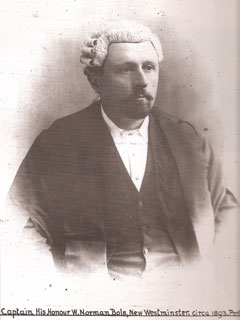 In the 1860s, smallpox and tuberculosis devastated the Tsleil-waututh people and led eventually to their abandonment of Tum-tumay-whueton and the subsequent move to what would become the Burrard Reserve. John Hall and Stephen Decker, trail builders and hand loggers, became the first non-native settlers on Belcarra Peninsula a decade later. "John Hall's property included all of the present day Belcarra picnic site and over half the Belcarra Peninsula, as well as Turtle Head and Whiskey Cove." [1].
When Hall was charged with the murder of Mary Dish, his First Nations mother-in-law, on October 18, 1882, he was defended by William Norman Bole (who later became Judge Bole). Judge H.P.R. Crease reduced the charge to manslaughter and Hall served seven years in jail. Unable to pay Bole, Hall used his property in lieu of cash. Subsequent to taking over Hall's land, Bole named the area Belcarra, after a town in County Mayo, Ireland, the country of his birth. The name derives from two Celtic words Baal (sun) and Carra (fair or lovely land): The Fair Land Upon Which The Sun Shines.
In the 1860s, smallpox and tuberculosis devastated the Tsleil-waututh people and led eventually to their abandonment of Tum-tumay-whueton and the subsequent move to what would become the Burrard Reserve. John Hall and Stephen Decker, trail builders and hand loggers, became the first non-native settlers on Belcarra Peninsula a decade later. "John Hall's property included all of the present day Belcarra picnic site and over half the Belcarra Peninsula, as well as Turtle Head and Whiskey Cove." [1].
When Hall was charged with the murder of Mary Dish, his First Nations mother-in-law, on October 18, 1882, he was defended by William Norman Bole (who later became Judge Bole). Judge H.P.R. Crease reduced the charge to manslaughter and Hall served seven years in jail. Unable to pay Bole, Hall used his property in lieu of cash. Subsequent to taking over Hall's land, Bole named the area Belcarra, after a town in County Mayo, Ireland, the country of his birth. The name derives from two Celtic words Baal (sun) and Carra (fair or lovely land): The Fair Land Upon Which The Sun Shines.
Throughout the early 1900s Judge Bole and his wife Florence sold and bought and sold again various parts of Hall's and other properties but eventually Florence Bole acquired 96 acres of Crown land south of the picnic area in 1906 and in 1914, her son Percy Bole purchased an additional 46 acres. These 142 acres became known as the Bole Estate - now Belcarra South. Judge Bole died in 1923 at the age of 77.
John "Percy" Hampton Bole and The Bole House
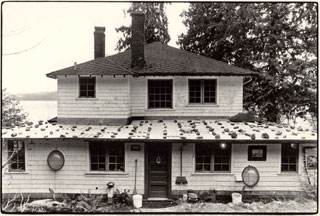 Percy Bole (1882-1966) was a war veteran of World War I and a lawyer. In the 1930's he retired with his wife Norah Kathleen to the Bole Estate. They began building the Bole House in 1934 and lived on the property year 'round with boat access only and without telephone or electricity until 1959.
In 1976, Norah Kathleen Bole made a donation to UBC of a valuable collection of Indian artifacts Percy Bole had gathered on the property. She died in 1984 at the age of 92.
Percy Bole (1882-1966) was a war veteran of World War I and a lawyer. In the 1930's he retired with his wife Norah Kathleen to the Bole Estate. They began building the Bole House in 1934 and lived on the property year 'round with boat access only and without telephone or electricity until 1959.
In 1976, Norah Kathleen Bole made a donation to UBC of a valuable collection of Indian artifacts Percy Bole had gathered on the property. She died in 1984 at the age of 92.
The largest house on the property, the Bole House was built over a period of years (1934-1942). It has been described as a country retreat situated at the end of an access road on a heavily treed waterfront site that faces views of Indian Arm, Burrard Inlet and the North Shore. In 2004, it received official heritage status and is listed in the Canadian Registry of Historic Places. "Vernacular in style and construction, the Bole House reflects a leisurely lifestyle from an era when there were still large tracts of waterfront land available within easy reach of Vancouver." [2]. The house has been continuously tenanted until recently when Metro Vancouver wanted the house vacated so restoration could proceed.
The Cottages
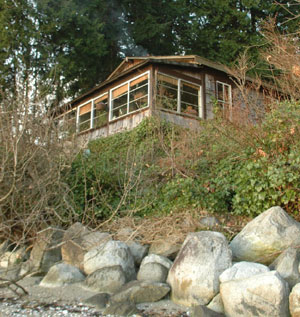 Who built the seven summer cottages remains a mystery.
It has always been said that they were built by friends and relatives of the Bole family but by the early 50s they were simply being leased out by Percy Bole.
One former leaseholder believes Cottage 2 (counting south from the picnic area) was built in 1912 - well before the Bole House was built - and a Royal Columbian newspaper dated 1936 was removed from an inside wall of Cottage 7 during renovation.
Another point of interest is that Cottage 1 has exactly the same floor plan as the ground floor of the Bole House, leading to speculation that this cottage may have been the original small cottage of Judge Bole or Percy Bole before Percy decided to move further south along the shoreline to build the more-substantial Bole House.
Building inspectors have estimated all the cottages were built in the 1920s, 30s and 40s.
Who built the seven summer cottages remains a mystery.
It has always been said that they were built by friends and relatives of the Bole family but by the early 50s they were simply being leased out by Percy Bole.
One former leaseholder believes Cottage 2 (counting south from the picnic area) was built in 1912 - well before the Bole House was built - and a Royal Columbian newspaper dated 1936 was removed from an inside wall of Cottage 7 during renovation.
Another point of interest is that Cottage 1 has exactly the same floor plan as the ground floor of the Bole House, leading to speculation that this cottage may have been the original small cottage of Judge Bole or Percy Bole before Percy decided to move further south along the shoreline to build the more-substantial Bole House.
Building inspectors have estimated all the cottages were built in the 1920s, 30s and 40s.
In the late 1950s, Percy Bole offered to sell the cottages and the land on which they stood to the then leaseholders for a rumoured $100,000. The offer of sale was declined and Bole eventually sold the cottages in 1960 and, later, the Bole House in 1965 to a speculator whose plan it was, apparently, to build a hotel, marina, restaurant and other tourist attractions. The 1971 expropriation by GVRD put an end to that plan.
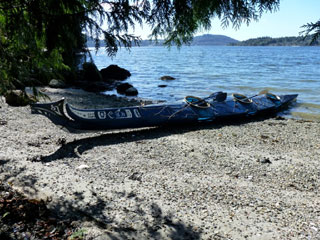 Many interesting characters have lived in Belcarra South including Verna Barrett, the first mayor of the Village of Belcarra (incorporated on August 22, 1979) and her family who lived in Cottage 1 while their new house was being built on Coombe Lane, north of the park.
Many interesting characters have lived in Belcarra South including Verna Barrett, the first mayor of the Village of Belcarra (incorporated on August 22, 1979) and her family who lived in Cottage 1 while their new house was being built on Coombe Lane, north of the park.
Of local, national and international interest is author, technology historian and kayak builder George Dyson who lived from 1972-1975 in a treehouse thirty meters up a Douglas fir adjacent to the Bole House. From 1978-1989 George lived in the Bole House where he hand-built many baidarkas - a specialized 'skin' boat based on Aleut design. George and his father, astrophysicist Freeman Dyson are the twin subjects of Kenneth Brower's Starship and The Canoe. George Dyson's books include Baidarka, Darwin Among The Machines, Project Orion: The Atomic Spaceship, and Turing's Cathedral. One of Dyson's early 3-person baidarkas is shown here, still in fine form in 2012 when the photo was taken.
All of the cottages are now occupied year 'round and much loved by those who live here despite windstorms and snowstorms, plenty of rain and none of the modern conveniences like washers, dryers and cable TV.
References:
[1] Between Forest and Sea, The Belcarra Historical Group, Belcarra, B.C., 1998, p. 25.
[2] City of Port Moody Heritage Register, p. 13.
